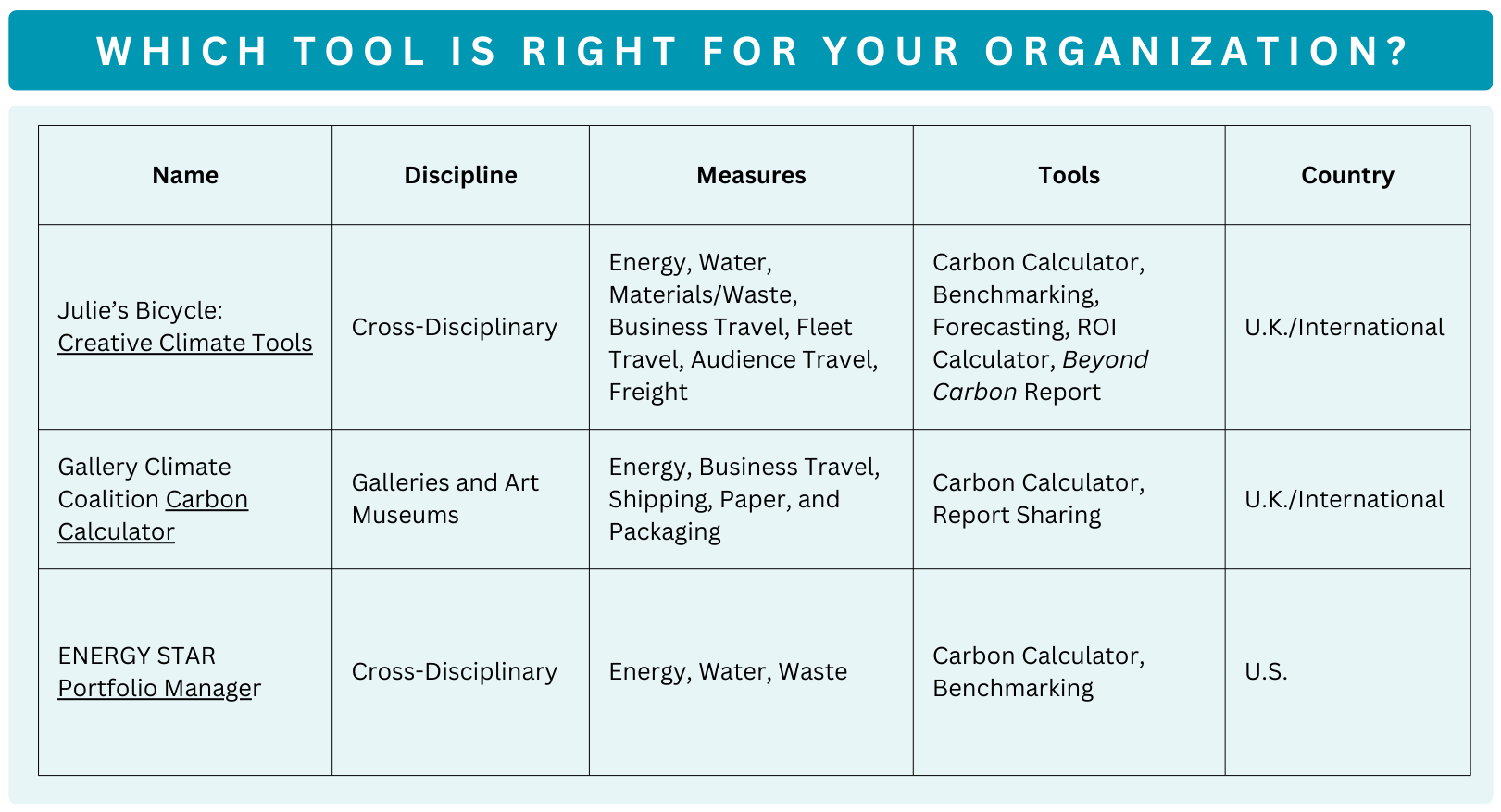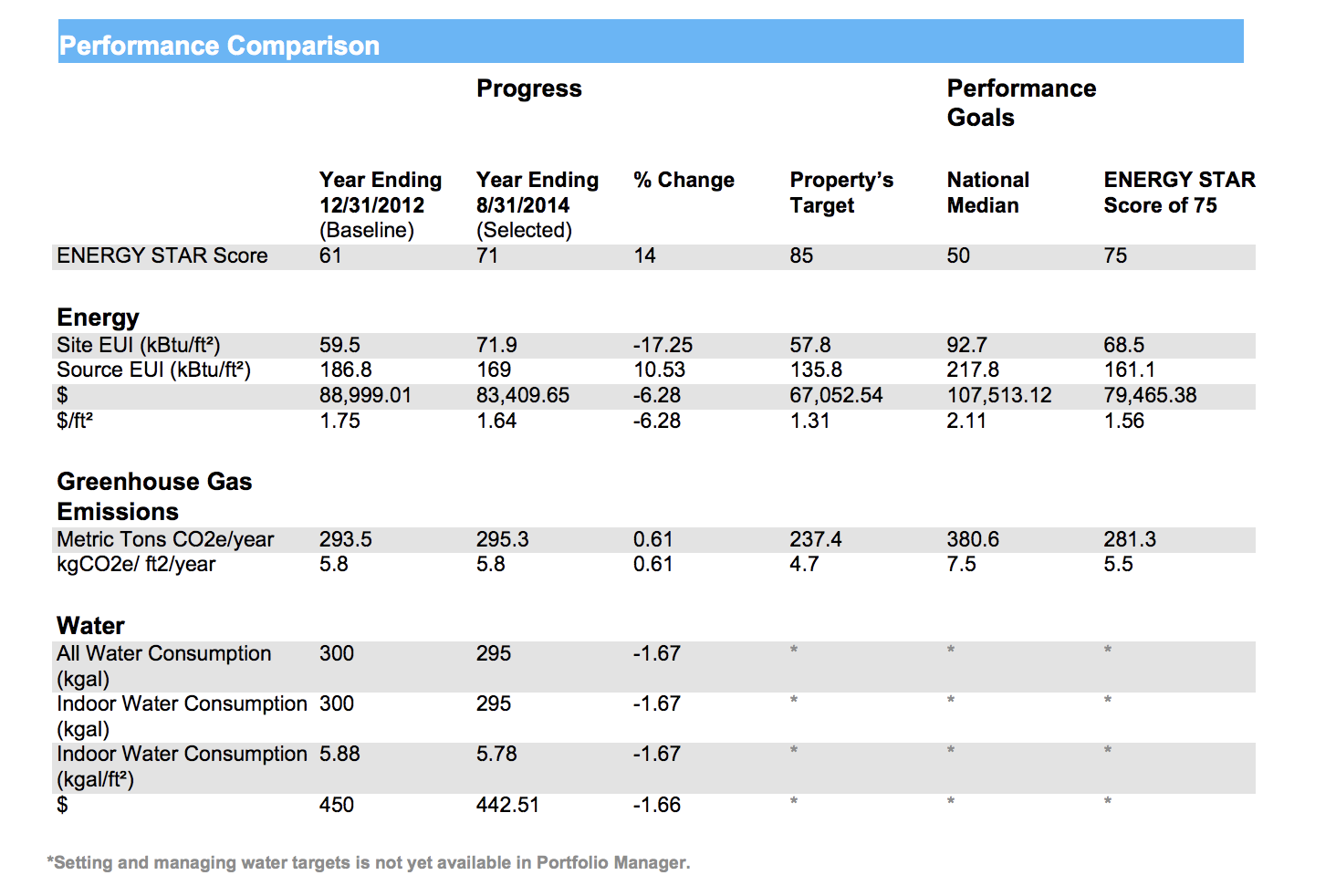introduction
As momentum grows around global climate goals, a number of arts organizations are taking a larger look at their environmental impacts and incorporating sustainability into their values and strategies. Often, the first step is to measure current emissions levels associated with the facility or program to establish a benchmark for change. While this may not capture the full picture of an organization’s impact, it creates a standardized data collection structure to inform future operational decisions.
By quantifying and standardizing energy use, materials, travel, and other heavy sources of emissions, an organization can prioritize efficient and cost-effective solutions. While reporting remains largely voluntary for arts organizations in the United States, funders, lawmakers, and other community stakeholders are starting to call for increased transparency.
To simplify this process, a variety of industry-specific tools are available to estimate CO2e emissions in arts and culture. Julie’s Bicycle, Gallery Climate Coalition, and ENERGY STAR Portfolio Manager emerged as widely used emissions calculators, because of their ease of use, established network to share and compare results, and in some cases, adoption by funders or regulatory bodies. Recognizing the range of needs across artistic disciplines, each contains different features tailored for a variety of operational practices.
Image created by author.
JULIE’S BICYCLE
Julie’s Bicycle is a non-profit organization, based in the United Kingdom, with the mission of “mobilising the arts and culture to take action on the climate, nature and justice crisis.” Through research, advocacy, and educational programming, Julie’s Bicycle has become a leading international resource in this space.
Julie’s Bicycle offers a free, web-based impact calculator called Creative Climate Tools, which helps cross-disciplinary organizations quantify emissions related to a specific project or facility. The tool is designed to accommodate a wide array of disciplines, from museums and galleries to music, theater, dance, and film. Calculations include energy use, water, materials/waste, business travel, audience travel, and freight. If a particular emissions source is not available within the tool, custom emissions values can be added from another source to show in the final report.
Image: Estimate emissions impact from materials usage with weight, type, and treatment
Image Source: Julie’s Bicycle
Using this data, additional functionality is available within Creative Climate Tools to make emissions calculations more meaningful, including benchmarking, forecasting, ROI calculation and the Beyond Carbon survey.
The benchmarking tool allows users to compare their emissions data with aggregate industry data for offices, venues, and outdoor events. If an organization is considering investing in an emissions reduction project, the ROI Calculator helps users estimate how long it will take to earn back an investment, and the forecasting tool shows how a change would impact emissions calculations without altering the organization’s final report.
To capture information that can’t be calculated through standard emissions measurements, Creative Climate Tools also has a Beyond Carbon survey, which operates like a series of checklists for sustainable practices. With tasks like hiring a sustainability professional, publishing environmental reports, or using electric vehicles, this allows organizations to track and communicate initiatives which may not otherwise be apparent in their reporting.
Image: Sample Emissions Report by Creative Climate Tools
Image Source: Julie’s Bicycle
GALLERY CLIMATE COALITION:
The Gallery Climate Coalition (GCC) is a non-profit organization focused on providing guidelines, lobbying, and fundraising for sustainability initiatives within the fine arts. Founded in the U.K., the member-based organization has international representation from artists, galleries, museums, and other related businesses. GCC is also a member of the Partners for Arts Climate Targets (PACT), which defines standards across the industry.
Scalable for a variety of projects and organization types, GCC’s Carbon Calculator generates emissions estimates using information on flights, shipping, and energy usage, as well as additional optional categories, like car or train travel, local artwork transport, packaging, and printing.
Image: Enter your flight route, class, and number of people for an estimate of CO2e emissions
Image Source: Gallery Climate Coalition
Once a report is completed, organizations are encouraged to share findings to the GCC website to compare progress and exchange knowledge. This calculator is more simple than other tools, balancing ease of use with accuracy (GCC). This makes it fairly user-friendly, however, it may not be as comprehensive as other tools. The calculator is best for measuring emissions on a project basis for artists, galleries or museums.
Image: GCC Carbon Report 2022
Image Source: Gallery Climate Coalition
Image: Gallery Climate Coalition
Image Source: Salone del Mobile
ENERGY STAR Portfolio Manager
For facility-based organizations, ENERGY STAR Portfolio Manager is an effective and well-established tool to understand building efficiency and associated emissions. ENERGY STAR was established by the U.S. Environmental Protection Agency, and though not directly associated with the arts, it is a commonly used for reporting across the industry.
The tool measures energy, water, and waste, with benchmarking available specific to property type - including museums, performing arts centers, movie theaters and more.
Portfolio Manager has been recommended by Environment & Culture Partners, and was used at a large scale in the 2023 Culture Over Carbon report of energy use in museums, zoos, and botanical gardens. Additionally, the Frankenthaler Climate initiative, a leading private initiative dedicated to funding climate work in visual arts sector, requires grant recipients to report through ENERGY STAR.
In addition to calculating emissions, ENERGY STAR generates an efficiency rating (1-100), and buildings with scores above 75 are eligible to earn an ENERGY STAR certification. Additionally, building efficiency is represented through an Energy Use Intensity (EUI) score, dividing total building annual energy use by the square footage. Depending on the service area and provider, Portfolio Manager may automatically integrate an organization’s energy use data, so little manual data entry is required.
Image: Sample ENERYGY STAR Portfolio Manager report
Image Source: ENERGY STAR
Conclusion
These tools translate business data into a cohesive language of emissions impact to make it easier to share information, learn, and quantify change. The right emissions calculation tool may vary based on organization type, scope of work, and motivation for reporting. There is no “one size fits all” calculator that will meet the needs of every arts and cultural organization, so it may require multiple tools to get the most comprehensive understanding of sustainability impact.
Julie’s Bicycle, Gallery Climate Coalition, and ENERGY STAR prioritize information relevant for arts and cultural facilities and practices, and simplify the process of measuring impact. By quantifying impact, the well-informed estimate can guide sustainability strategies, such as operational changes, facilities upgrades, carbon offsetting, strategic climate funds, and much more.
-
“About JB” Julie’s Bicycle. Accessed December 15, 2023. https://juliesbicycle.com/about-us/about-jb/
“About Us.” Gallery Climate Coalition. Accessed December 15, 2023. https://galleryclimatecoalition.org/about-us/
“Accessing utility data for benchmarking” ENERGY STAR. Accessed December 17, 2023.
https://www.energystar.gov/buildings/benchmark/find_utilities_provide_data_benchmarking
“Calculator User Guide.” Gallery Climate Coalition. Accessed December 15, 2023. https://galleryclimatecoalition.org/usr/library/documents/main/calculator-user-guide-v2-aug-22.pdf
“Carbon Calculator” Gallery Climate Coalition. Accessed December 15, 2023. https://galleryclimatecoalition.org/carbon-calculator/
“Carbon Reports” Gallery Climate Coalition. Accessed December 15, 2023. https://galleryclimatecoalition.org/carbon-reports/
“Creative Climate Tools: User Guide” Julie’s Bicycle. https://sway.office.com/WGFiWGUQBc4WZulm?ref=Link
Bowles, Webly et al. “Culture Over Carbon: Understanding the Impact of Museums’ Energy Use.” New Buildings Institute. September 2023.
"Environmental Reporting for NPOs” Julie’s Bicycle. https://juliesbicycle.com/our-work/arts-council-programme-draft/npo-reporting/
“Frankenthaler Climate Initiative.” Accessed December 17, 2023. https://www.frankenthalerclimateinitiative.org/about-6-1
“Grantee Reporting” Frankenthaler Climate Initiative. Accessed December 17, 2023. https://www.frankenthalerclimateinitiative.org/grantee-reporting
“How Portfolio Manager Calculates Greenhouse Gas Emissions” ENERGY STAR. Accessed December 17, 2023. https://www.energystar.gov/buildings/benchmark/understand_metrics/how








